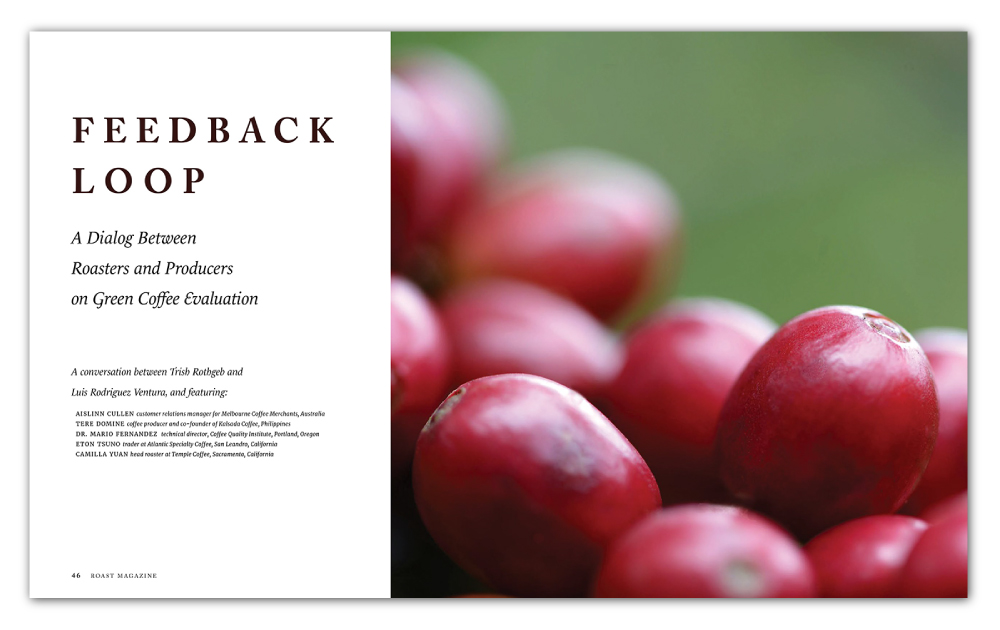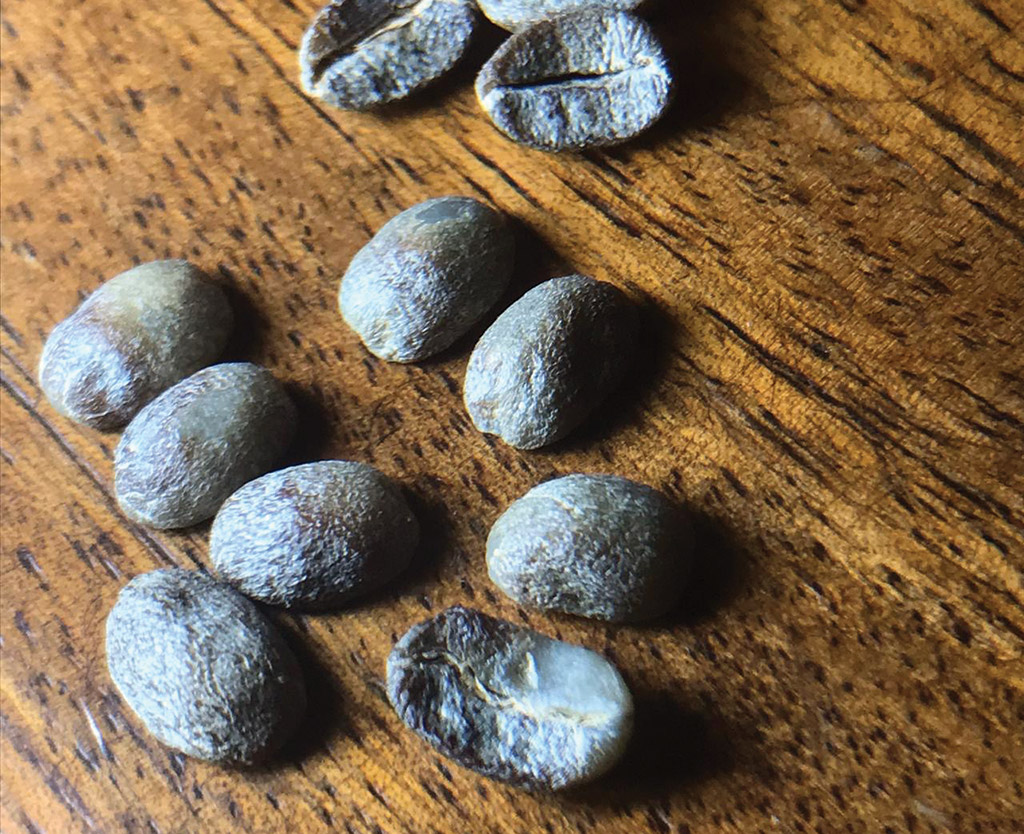(Editor’s note: The following comes from an article that appeared in the March/April 2020 issue of Roast Magazine. Click here to read the full article.)
A conversation between Trish Rothgeb, co-founder and roastmaster for Wrecking Ball Coffee Roasters in San Francisco, and Luis Rodriguez Ventura, coffee grower and owner of CAFERIUM in El Salvador, and featuring:
- Aislinn Cullen, customer relations manager for Melbourne Coffee Merchants, Australia
- Tere Domine coffee producer and co-founder of Kalsada Coffee, Philippines
- Dr. Mario Fernandez, technical director, Coffee Quality Institute, Portland, Oregon
- Eton Tsuno, trader at Atlantic Specialty Coffee, San Leandro, California
- Camilla Yuan, head roaster at Temple Coffee, Sacramento, California
A few years ago, I contacted Luis Rodriguez Ventura, a friend and coffee producer based in El Salvador, to ask him about a green coffee defect I kept finding in the new season’s Central American offers. This defect didn’t really fit into the classification tool I was using, and I was a bit confused. The tool I use is SCA’s Arabica Green Coffee Defect Handbook, not only for training others at the Coffee Quality Institute’s Q Arabica Grader course, but also within the walls of my own small roastery in San Francisco. The question I had that day grew into a longer conversation, and now, both Luis and I will make a point to contact one another when we find something interesting in our green coffee.
The coffee world is changing, whether it’s due to climate change, processing trials, or new hybrid varieties. While change is exciting and brings new challenges and discussion to the table, we may find that the form the discussion takes needs an adjustment as well. Are we making progress when it comes to giving and receiving feedback between producers and buyers? The author Linda Lambert said, “One good conversation can shift the direction of change forever.”
The following is a conversation that continues today between Luis and me. We spoke over Skype and corresponded with email. In the process, I asked some friends to chime in with their thoughts. With so much to explore, it should be noted that this conversation is just a small selection of what we’ve talked about. We’re looking forward to having many more exchanges like this.
It’s important to remember that green coffee contracts are legally binding. Sometimes even a handshake contract or specifics statements during a verbal conversation can be considered legally binding. Purchasing agreements run the gamut from formal to informal, but ultimately, all of them rely on relationships. Any of the subjects we discussed here can be fully detailed within a contract (which is certainly recommended if circumstances warrant it), but a contract is not a conversation. A contract is in lieu of, or the result of, a larger dialog. For this piece, we wanted to focus on a few of the many subjects we could be discussing as buyers and sellers of specialty coffee and find ways to learn from each other. Hopefully we can go on to develop those strong, solid partnerships that everyone in the green coffee space yearns for. —Trish Rothgeb

From top left to bottom right: Trish Rothgeb, Luis Rodriguez Ventura, Aislinn Cullen, Eton Tsuno, Camilla Yuan, Tere Domine, and Dr. Mario Fernandez.
TRISH: What’s the most common feedback that roasters and producers exchange regarding green coffee?
LUIS: In terms of feedback, most of what we normally get is the relation between the Pre-Ship-Sample (PSS)—or offer sample—to the actual arrival in terms of cupping scores. These variations are typically minor and do not cause an issue; most buyers understand that there are many factors that can affect a landing coffee’s quality apart from farming or processing practices. Dealing mostly with specialty coffee exports, I tend to get very little feedback regarding physical characteristics, screen size or defects, however sometimes we get moisture readings [and] very rarely water activity (aW) feedback …[sometimes] quakers, but again dealing with specialty coffees this tends to almost never appear to be an issue. I believe due to a prep that normally goes from zero to less than five secondary defects, there is very little to add from [roasters’] side here.
ETON: We send physical analysis of moisture content, water activity, density and cupping notes with every sample approval/rejection. This is all part of our quality assurance protocols to ensure coffee delivered is in fact the coffee quality contracted and that origin is calibrated with our findings. If there is an issue with the coffee, we will send defect count, screen size distribution and often an ultraviolet (UV) light analysis as a photo or video as well.
TRISH: Ultraviolet light analysis is an interesting development as a standard by which to measure quality. I say “interesting” because I don’t think everyone’s clear about what is glowing under the light. Nevertheless, I’ve heard of more than a few roasters drawing their producing partners’ attention to it. The assumption is that green coffee that glows under UV light will be of a lesser quality.
MARIO: The glow under UV light is likely related to the metabolic byproducts of processing. So far, it seems related to 1: beans with dead/ejected embryos, 2: beans intensely fermented, and 3: wet-hulled process, but not always.
LUIS: Water activity is most definitely a great tool to make decisions, but I think there is not enough information available to make a solid statement of how, where and when to take this measurement.
TRISH: What I don’t understand about water activity and moisture content [is how] it relates to storage, shipping and location.
LUIS: I have a hard time believing my conditions in the warehouse in El Salvador are the same as my lab or the lab of my buyer, or the warehouse of an importer in Oakland for two months, or the warehouse of a buyer in Sweden during January. Even if I get feedback from the buyers, most growers can’t spend $2,000 on a water activity meter. Don’t you find fascinating this topic (aW)? How much we can still learn and apply in our industry?
TRISH: I think most roasters who take these readings, or run through a green coffee evaluation upon arrival, are trying to identify the lot more than anything else. It’s not typically going to be mentioned during cupping. In my mind, this is where it could evolve.
AISLINN: If we get a water activity reading that is particularly high on PSS or landing, we also flag the coffee as potentially having an issue down the track and instruct our customers to use the coffee quickly. We find the water activity and moisture activity readings useful but not always directly correlated to the cup quality.
LUIS: Obviously with some exceptions; there was one time that I got a sample rejected by aW and moisture content, so I resampled every small day lot and isolated those with better aW and moisture. Two small day lots out of 11 were throwing off the readings, and that meant a huge difference in price.
Having said that, there have been times where I’ve received very good reports on offer samples and then, because the coffee arrived similar to the offer samples, I didn’t receive any additional feedback besides the follow-up email saying everything seems to be fine (or perhaps a particular sample lost some points due to delays in shipping or warehousing issues).








Comment